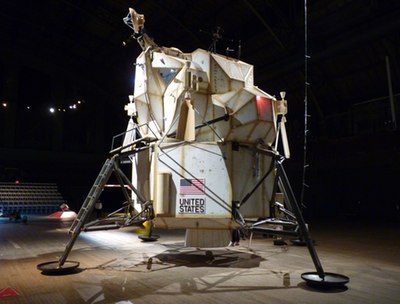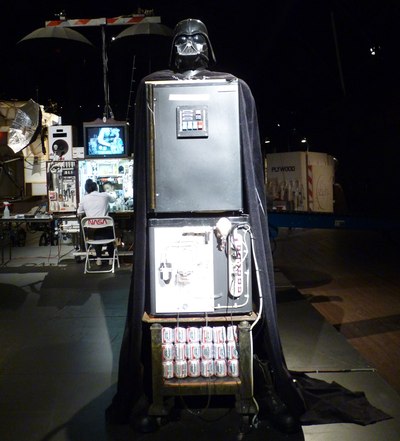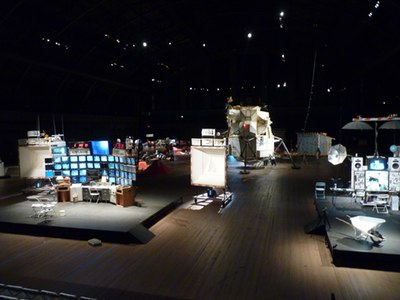Mars on the Upper East Sideby Jeff Foust
|
| As the name suggests, “Space Program: Mars” is Sachs’s vision of a Mars expedition, turning the drill hall of the armory into the Red Planet with varying degrees of verisimilitude. |
No, no one will confuse the Park Avenue Armory on Manhattan’s Upper East Side with Mars. However, the facility is hosting “Space Program: Mars”, an art installation by artist Tom Sachs. Now entering its final week, the exhibition is a sequel of sorts to his “Space Program” exhibition in 2007 in Beverly Hills. That exhibition was a reimagining of the Apollo lunar landings, complete with a full-sized replica of the lunar lander and spacesuited astronauts, made out of scavenged or otherwise off-the-shelf materials. (“Going to the Moon was the art project of the twentieth century,” Sachs said in a 2007 press release about the original “Space Program” exhibition.)
 A full-scale replica of a lunar lander—equipped inside with, among other things, a liquor cabinet—is the centerpiece of “Space Program: Mars”. (credit: J. Foust) |
As the name suggests, “Space Program: Mars” is Sachs’s vision of a Mars expedition, turning the drill hall of the armory into the Red Planet with varying degrees of verisimilitude. The full-sized lunar lander from his 2007 show is back, serving as the centerpiece of the exhibition: the show program claims that this lander is the only full-scale replica of the LEM that is supported solely by its four landing legs. Yet the Martian surface is nothing more than the old wooden floor of the drill hall, studded with some red angular blocks intended to represent Martian rocks. Exhibition staff—which the program calls “Grummans”, a nod to the company that built the original lunar lander on Long Island—crisscross the floor, sometimes on bikes and skateboards, performing maintenance or conducting demonstrations. (There were no demonstrations during a visit on a recent Sunday afternoon, but this Saturday they plan to hold a “real-time Endurance Demonstration” that will put all of the exhibit’s items through their paces.)
That attention to detail, coupled with perhaps a sense of whimsy or a predilection for non-sequiturs, is visible throughout the exhibition. In one corner is a “biology lab”: a meticulously designed self-contained greenhouse, which Sachs uses to grow poppies to symbolize “man’s simultaneous cultivation and exploitation of the Earth’s natural resources,” as the program explains. (Like the original “Space Program,” the lab and the other items are all made from salvaged or readily-available materials.) Elsewhere is a workstation with a large collection of tools, all labeled with unusual, or at least unexpected and unexplained, names: a hammer named “Obama”, a pair of needlenosed pliers named “Stevie Wonder”, and a drill labeled “Mike Tyson”. And the mini refrigerator topped by a Darth Vader cape and mask, with cans of Budweiser underneath? You’re on your own there.
 Come to the Dark Side, Luke, and have a Bud. (credit: J. Foust) |
So what’s the message of “Space Program: Mars”? In the program, Sachs says that it is designed to explore the quandaries and contradictions of our current society: “The ongoing deterioration of our planet’s resources and the desire to find life beyond Earth leads us to question our individual and collective roles in environmental destruction and the ethics of colonialism and pioneering.” That message, though, may have been lost on many people attending the exhibit, particularly the kids exploring the items during a recent visit. They seemed less interested in messages about environmental destruction and the ethics of colonialism than in the opportunity to climb inside the LEM.
While the exhibit’s message of “asking barbed questions of modern creativity that relate to conception, production, consumption, and circulation,” in the words of its website, might not connect with every attendee, it’s still a fascinating look at how one artist depicts space exploration. At the very least, it’s a lot easier to get to this rendition of the Red Planet that the real thing—barring delays on the subway, of course.
